
Buy Hospital Beds with Rails for Elderly Patients: What to Know
📋 KEY TAKEAWAYS
| Feature | Full-Length Rails | Half-Length Rails | Quarter Rails/Assist Bars |
|---|---|---|---|
| Fall Protection | Maximum | Moderate | Minimal |
| Mobility Support | Limited access | Good balance | Maximum access |
| Price Range | $150-$300/pair | $100-$250/pair | $80-$200/each |
| Best For | High fall risk, confusion | Moderate assistance needs | Mobility aid, minimal fall risk |
Best Overall Package: Icare Adjustable Electric Home Hospital Bed IC333 with Icare Half-Length Side Rails
Budget Option: Costcare Semi-Electric Bed B120C with Costcare Half Rails Model BPR120C
For High Fall Risk: Ultra Low Hospital Bed Medacure ULB3.9 with Costcare BPR230C Full Rails
Buy hospital beds with rails to ensure elderly patients have both safety and mobility support at home.
Safety rails are essential accessories that prevent falls while also providing assistance with repositioning, sitting up, and transfers.
Different rail types serve varying levels of patient needs, from full protection to mobility assistance.
After thorough research comparing various options, the Icare Adjustable Electric Home Hospital Bed IC333 paired with Icare half-length rails emerges as the best overall package for elderly care. This combination provides excellent safety features while maintaining a home-friendly appearance and preserving patient independence.
In this comprehensive guide, we'll help you navigate the process of selecting the right hospital bed with appropriate rails for elderly care.
We'll cover the types of rails available, their benefits, safety considerations, and how to choose the perfect hospital bed and rail combination based on specific patient needs.
Types of Hospital Bed Rails for Elderly Care
When purchasing a hospital bed for an elderly patient, understanding the different rail options is crucial for balancing safety with independence and mobility.
Full-Length Rails
Full-length hospital bed rails extend along most or all of the mattress length, providing maximum fall protection for elderly patients.
Key benefits of full-length rails include:
- Complete protection: Prevent falls along the entire bed length
- Maximum security: Ideal for patients with confusion or dementia
- Stable support: Provide continuous grip surface for repositioning
- Comprehensive coverage: Protect patients during medication-induced drowsiness
- Caregiver leverage: Assist with moving and turning patients
The Costcare BPR230C Full Rails are excellent examples of durable, medical-grade full-length rails that provide comprehensive protection.
Potential drawbacks to consider:
- May create feelings of confinement for some patients
- Restrict independent bed entry and exit
- Require more careful assessment for entrapment risks
- Take up more room space when lowered
- May be overkill for patients with good cognition
Half-Length Rails
Half-length rails cover approximately half the mattress length and are typically positioned at the head section of the bed.
Advantages of half-length rails:
- Balance of safety and independence: Prevent falls while allowing easier access
- Mobility assistance: Provide grip support for sitting up and repositioning
- Less restrictive: Create a more open feeling for patients
- Transfer friendly: Allow caregivers better access for transfers
- Space efficient: Take up less room when lowered
The Costcare Homecare Half Rails Model BPR120C represent excellent quality in this category, balancing protection with accessibility.
Situations where half-rails work best:
- Patients with good cognitive awareness
- Those who need moderate fall protection
- Individuals who reposition themselves frequently
- Situations requiring regular caregiver access
- Patients who value some independence
Quarter Rails and Assist Bars
Quarter rails and assist bars are the smallest rail options, designed primarily to assist with mobility rather than prevent falls.
Key features of assist bars include:
- Mobility focus: Designed specifically to aid in repositioning and sitting up
- Maximum independence: Allow unhindered bed entry and exit
- Minimal restriction: Preserve patient dignity and autonomy
- Targeted support: Positioned exactly where grip assistance is needed
- Discrete profile: Less institutional appearance
The Emerald Q Assist Bar Medical Bed Assist Rail exemplifies this category with its ergonomic design focused on mobility support.
Best applications for assist bars:
- Patients with good balance and cognition
- Those primarily needing help sitting up
- Individuals with minimal fall risk
- Situations prioritizing independence
- As supplementary support alongside other safety measures
Hospital Bed and Rail Safety Considerations
When purchasing hospital beds with rails for elderly care, several critical safety factors must be considered to prevent injuries and ensure proper use.
Entrapment Risks and Prevention
Bed rail entrapment is a serious safety concern that occurs when a patient becomes caught between the rail and mattress or within rail openings.
Key entrapment zones to assess:
- Rail-to-mattress gaps: Should be less than 4.25 inches
- Rail-to-headboard spaces: Potential head entrapment areas
- Between rail bars: Openings that could trap limbs
- Under the rail: Space between bottom rail and mattress
- Between split rails: Gaps between separate rail sections
Prevention measures include:
- Using proper-fitting hospital bed mattresses designed for the specific bed
- Installing gap fillers or padding like Icare Homecare Bed Padded Side Rail Covers
- Selecting rails designed to current safety standards
- Regular inspection of all gaps and spaces
- Proper installation by trained personnel
FDA Guidelines and Compliance
| FDA Safety Zone | Requirement | Why It Matters |
|---|---|---|
| Zone 1 | Within the rail | Prevents head/neck entrapment in rail openings |
| Zone 2 | Between rail and mattress | Most common entrapment zone for elderly |
| Zone 3 | Between rail end and headboard | Risk area when patient moves toward head of bed |
| Zone 4 | Between rail end and footboard | Risk area when patient moves toward foot of bed |
| Zone 5 | Between split bed rails | Gap created between separate rail sections |
| Zone 6 | Between end of rail and side edge of mattress | Creates gap when mattress compresses |
| Zone 7 | Between head/footboard and mattress end | Gap at mattress ends that can trap patients |
The FDA has established guidelines for hospital beds and rails to minimize entrapment risks.
When purchasing, ensure that:
- The bed and rails are FDA-compliant with current safety standards
- Products feature entrapment prevention designs
- Rails are compatible with the specific bed model
- Documentation includes safety certification
- The seller provides proper installation instructions
All hospital beds and rails available from MedShopDirect.com meet or exceed these safety requirements.
Alternative Safety Measures
In some cases, alternatives or supplements to traditional rails may be appropriate for elderly safety.
Effective alternatives include:
- Ultra-low beds: The Ultra Low Hospital Bed Medacure ULB3.9 lowers to just 3.9" from the floor, minimizing fall injury risk
- Bed alarms: Alert caregivers when a patient attempts to exit
- Floor mats: Provide cushioning if falls occur
- Positioning wedges: Help maintain position without rails
- Perimeter mattresses: Feature raised edges to prevent rolling
When to consider alternatives:
- For patients who resist rail use
- When rails cause agitation or confusion
- In cases where entrapment risk is high
- For facilities with rail reduction policies
- When independence is a high priority
Choosing the Right Hospital Bed with Rails for Specific Needs
Different elderly conditions require specific features in both beds and rails to ensure optimal care and safety.
For Fall Risk and Dementia
Elderly patients with high fall risk, confusion, or dementia have specific safety requirements.
The best bed and rail combination includes:
- Ultra-low beds: The Low Profile Hospital Bed Prius Descend Ultra minimizes fall injury risk with its floor-level capability at $2,450
- Full-length rails: Complete protection along the entire bed
- Secure locking mechanisms: Prevent patient manipulation
- Padded rails: Reduce injury risk if contact occurs
- Gap-free design: Eliminate potential entrapment areas
For maximum safety, combine full rails with floor mats and bed exit alarms for comprehensive protection.
Key features to look for:
- Bed height lowers to 7" or less from floor
- Rails with minimal gaps or openings
- Smooth, easy-to-clean surfaces
- Tamper-resistant locks
- Compatible with perimeter mattresses
For Limited Mobility and Transfers
For elderly patients who require assistance with transfers and have limited mobility, specific features facilitate safer movement.
Optimal setup includes:
- Hi-Lo beds: The Medacure Ultra Low Hospital Bed ULB7/30-CLS offers ideal transfer height flexibility (7"-30") at $1,741
- Half-length rails: Balance of security and access
- Transfer aids: Gap-free transition zones
- Stable locking system: Prevents bed movement during transfers
- Ergonomic grip design: Rails shaped for optimal hand positioning
Most beneficial features:
- Height adjustment matching wheelchair height
- Rails that serve as support handles
- Locking casters for stability
- Smooth transitions between surfaces
- Appropriate width for caregiver access
For Bariatric Elderly Patients
Bariatric elderly patients require specialized equipment to ensure safety, comfort, and durability.
The ideal bariatric hospital bed with rails features:
- Heavy-duty frame: Supports 500-1000 pounds
- Reinforced rails: Higher weight capacity and durability
- Wider surface: 42"-60" width options
- Robust motors: Powerful enough for bariatric positioning
- Extended rails: Full coverage of wider mattresses
Options like the Costcare Bariatric Adjustable Hospital Bed B359 provide width options from 54"-60" with matching rails at $3,457.
Must-have bariatric features:
- Rails with higher weight capacity ratings
- Wider grip surfaces for leverage
- Reinforced mounting hardware
- Compatibility with bariatric mattresses
- Extended length to match expanded bed dimensions
For Maximum Independence with Safety
For elderly patients who value independence but still need support, certain configurations maximize autonomy while providing safety.
Best options include:
- Full electric beds: Allow independent position control
- Assist bars: The Icare Occupation Therapist U-Assist Side Rail provides mobility support without restricting access
- Strategic placement: Rails positioned where most needed
- Ergonomic design: Easy-grip surfaces for self-repositioning
- Intuitive controls: Simple operation for independent adjustments
This configuration works well for patients who:
- Have good cognitive awareness
- Need minimal fall protection
- Benefit from repositioning assistance
- Value controlling their environment
- Have some physical limitations but good judgment
Hospital Bed Mattress Compatibility with Rails
The proper hospital bed mattress is crucial for both comfort and rail safety, as improper mattress fit can create dangerous gaps and entrapment zones.
Proper Mattress Sizing and Rail Compatibility
Key considerations for mattress-rail compatibility:
- Exact dimensional match: Mattress should fill the entire frame with minimal gaps
- Proper thickness: Usually 6"-7" for standard rails (too thick creates gaps, too thin allows slipping underneath)
- Edge reinforcement: Prevents compression that creates rail gaps
- Articulation design: Segments that match the bed's movement points
- Appropriate firmness: Maintains shape under patient weight
Most rails are designed for standard hospital mattresses, but specialty surfaces may require rail extensions or specialized rails.
Pressure Relief Mattresses and Rail Considerations
For elderly patients at risk for pressure ulcers, specialized mattresses must be carefully matched with rails.
Important considerations include:
- Air mattress compatibility: Many air systems require specific rail heights
- Low air loss systems: May create additional space under rails
- Alternating pressure surfaces: Can change the effective rail height as cells inflate/deflate
- Foam mattress compression: Firmer edges prevent rail gap formation
- Mattress securement: Methods to keep specialty mattresses properly positioned
All hospital bed mattresses from MedShopDirect are designed to work safely with their compatible rails and beds.
Cost Considerations and Insurance Coverage
Understanding the financial aspects of purchasing hospital beds with rails helps ensure you make the most economical choice while meeting all medical needs.
| Item | Typical Price Range | Medicare Coverage |
|---|---|---|
| Semi-Electric Hospital Bed | $1,000-$1,800 | 80% when prescribed |
| Full-Electric Hospital Bed | $1,200-$2,500 | 80% when prescribed |
| Bariatric Hospital Bed | $2,000-$5,000+ | 80% when prescribed |
| Full-Length Rails (pair) | $150-$300 | Included with bed |
| Half-Length Rails (pair) | $100-$250 | Included with bed |
| Assist Bars (each) | $80-$200 | May require separate approval |
Medicare and Insurance Coverage for Beds with Rails
Medicare and most insurance plans will cover hospital beds with rails when they are deemed medically necessary.
Coverage requirements typically include:
- Doctor's prescription: Written order specifying medical necessity
- Qualifying condition: Document need for positioning, elevation, or safety
- In-home use: Intended for residential rather than facility use
- Authorized supplier: Purchase through approved DME provider
- Proper documentation: Complete all required paperwork
Medicare Part B typically covers 80% of the approved amount for medically necessary equipment like the Costcare Full Electric Hospital Bed B135C.
Documentation typically needed:
- Detailed written order from physician
- Face-to-face evaluation notes
- Medical records supporting necessity
- Certificate of Medical Necessity form
- Delivery and setup confirmation
Value Considerations Beyond Initial Purchase
When evaluating the overall value of hospital beds with rails, several factors beyond the initial purchase price should be considered.
Long-term value includes:
- Durability: Higher-quality beds and rails typically last 10-15 years
- Adaptability: Ability to adjust as patient needs change
- Warranty coverage: Protection against mechanical failures
- Service availability: Access to parts and repairs
- Resale value: Better-quality equipment maintains value
Additional cost factors:
- Delivery and setup fees (typically $100-$350)
- Extended warranty options
- Accessory
Additional cost factors:
- Delivery and setup fees (typically $100-$350)
- Extended warranty options
- Accessory compatibility with future needs
- Replacement mattress requirements
- Energy costs for electric models
Our Top Recommendations for Hospital Beds with Rails
After analyzing numerous options across various categories, these are our top recommendations for hospital beds with rails for elderly patients.
Best Overall: Icare Adjustable Electric Home Hospital Bed IC333
The Icare Adjustable Electric Home Hospital Bed IC333 paired with Icare half-length rails offers the ideal combination of safety, functionality, and aesthetics for most elderly patients at home.
Key features making this our top pick:
- Full electric operation with intuitive controls
- Home-friendly appearance that blends with décor
- Height range suitable for both transfers and fall prevention
- Quality rails that balance protection with accessibility
- Comprehensive accessory ecosystem for customization
With a starting price of $3,200, this package represents excellent value when considering its quality, durability, and feature set.
Best Budget Option: Costcare Semi-Electric Bed B120C
For those needing quality care on a limited budget, the Costcare Semi-Electric Bed B120C with Costcare Half Rails Model BPR120C provides excellent value.
This budget-friendly package delivers:
- Electric head and foot adjustment
- Manual height adjustment with crank
- Quality medical-grade construction
- Essential safety features
- Medicare-eligible when prescribed
At $1,068 for the bed with approximately $150 for the rails, this combination offers strong value while maintaining necessary safety features.
Best for Fall Prevention: Ultra Low Bed with Full Rails
For maximum fall protection with minimal injury risk, the Ultra Low Hospital Bed Medacure ULB3.9 paired with Costcare BPR230C Full Rails provides unmatched safety.
This safety-focused combination features:
- Industry-leading 3.9" minimum height
- Complete rail protection along entire bed length
- Full electric operation for all functions
- Medical-grade safety certifications
- Durable construction for long-term use
Starting at $2,240 for the bed plus approximately $200 for the rails, this package prioritizes maximum safety for high-risk elderly patients.
Frequently Asked Questions
Are side rails always included when purchasing a hospital bed?
Not always. Some hospital beds include basic rails, while others require separate purchase. Verify what's included in the base price.
Will Medicare cover hospital bed rails for elderly patients at home?
Medicare typically covers rails as part of the hospital bed package when medically necessary with a doctor's prescription.
How do I know which type of rail is right for my elderly parent?
Consider their fall risk, mobility level, cognitive function, and need for independence. Half-rails are best for moderate assistance needs.
Can regular bed rails be attached to a hospital bed, or must I use specific models?
Always use rails specifically designed for your hospital bed model. Regular bed rails lack proper mounting and safety features.
What's the minimum height a hospital bed should lower to for maximum fall safety?
For high fall risk patients, choose beds that lower to 7" or less from the floor; ultra-low models reaching 4"-5" offer maximum safety.
How often should hospital bed rails be inspected for safety?
Inspect rails weekly for loose hardware, damage, and proper locking. Check gaps whenever changing mattresses or bed components.
Can rails be added or changed after purchasing a hospital bed?
Most hospital beds allow for changing rail types as needs evolve, but verify compatibility with your specific bed model before purchasing.
















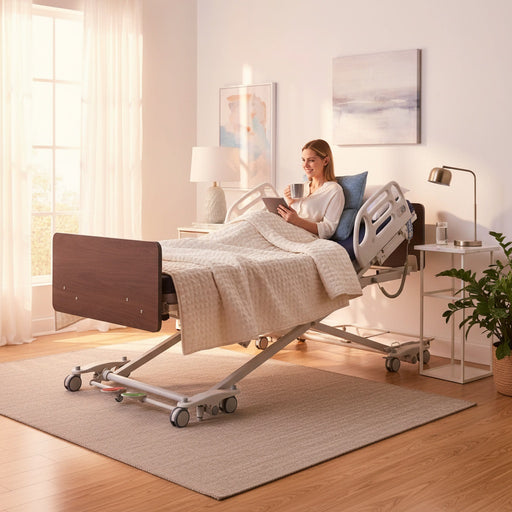
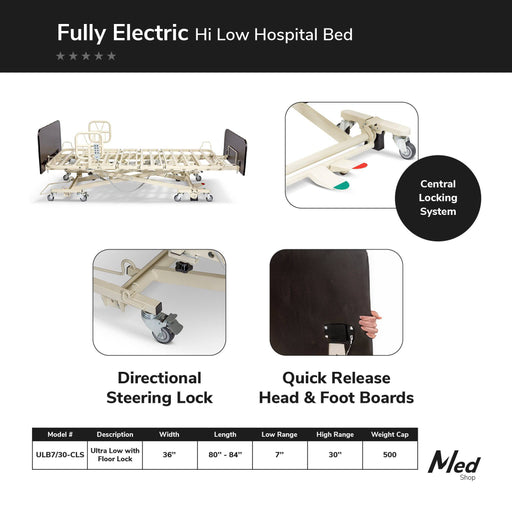
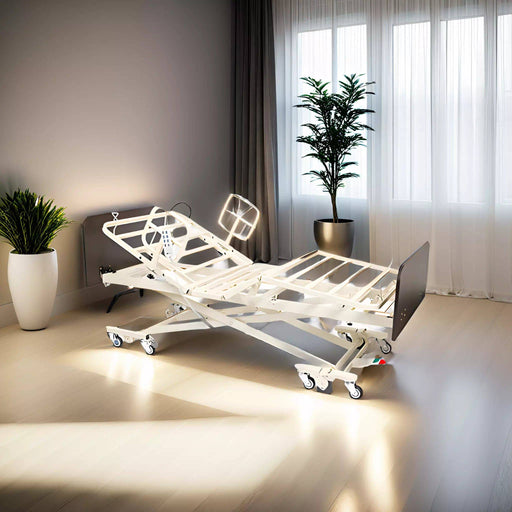


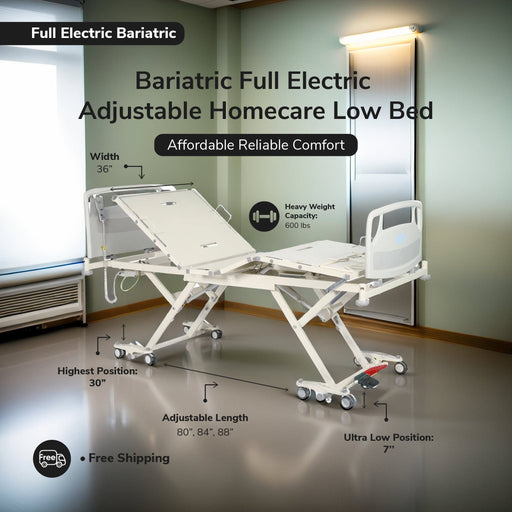
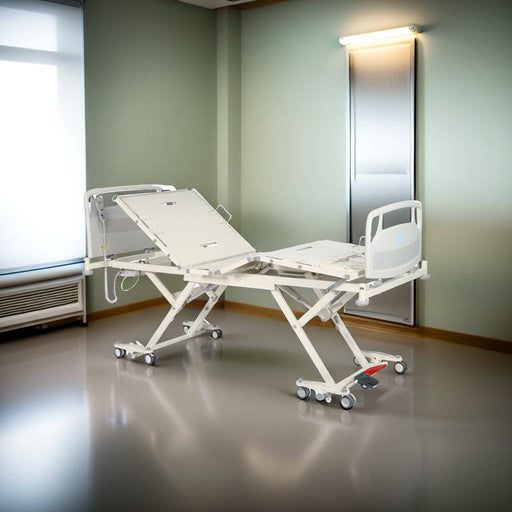
Leave a comment